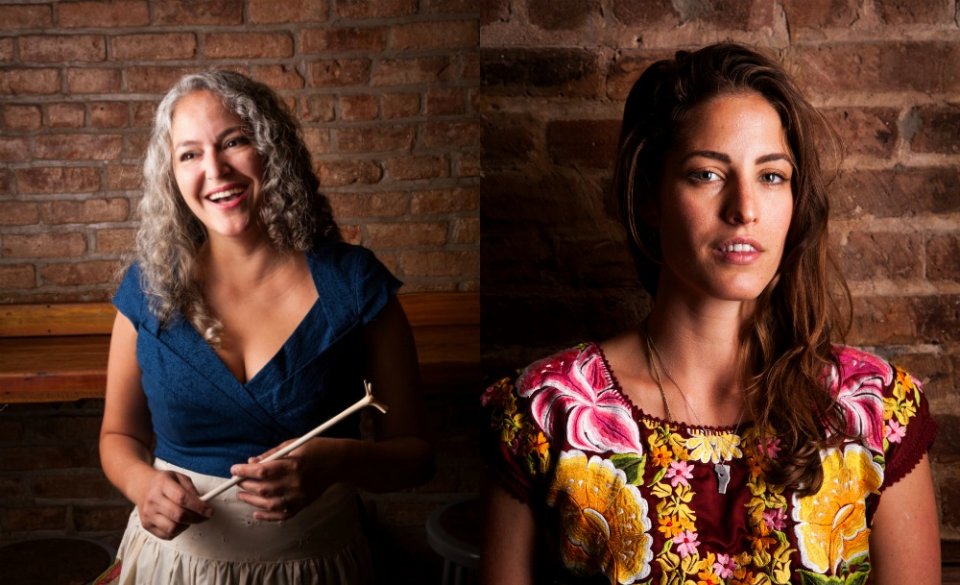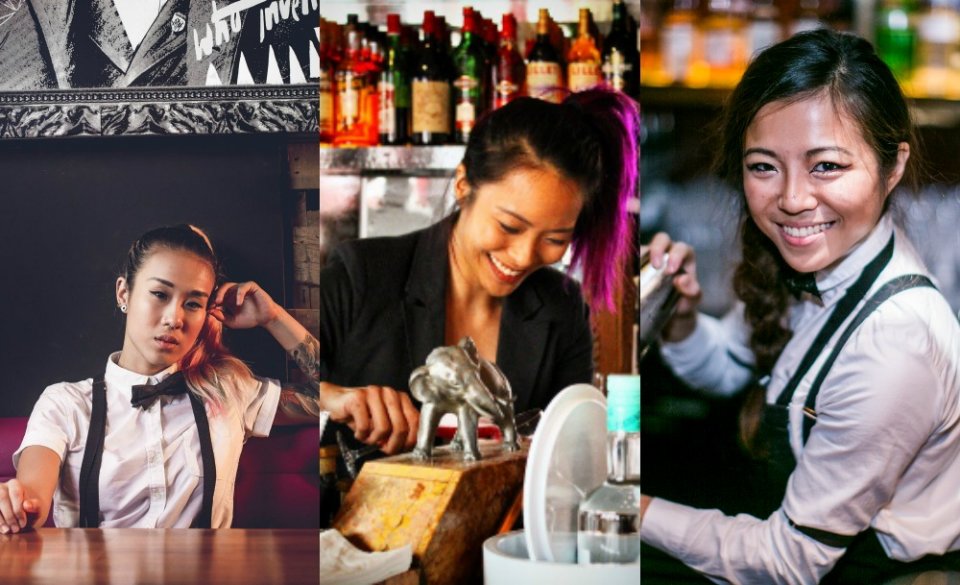What it’s like being a female bartender in Singapore
The bartenders behind the all-women competition Speed Rack explain
In the lead-up to International Women’s Day today, we are sure you have been contemplating a lot of serious feminist issues: why female board members in Singapore make 43% less than their male counterparts; whether getting free-flow bubbly and a manicure on the day undermines intersectionality; if you deserve that Vaniday promo through Helpling more than the woman who actually cleans your house. Well, add to that something else: even SG readers’ #1 interest (food and drink—duh) is not exempt from gender inequality.
Earlier this month, the prestigious Asia’s 50 Best Restaurants awards saw just two female chefs make the list, and our burgeoning cocktail scene still skews heavily male. Enter Speed Rack Asia, taking place this weekend, March 12, at Golden Mile Tower’s The Great Escape. The all-female bartending competition in the US, the UK and Canada, was founded in 2011, and is making its first foray into Asia. A whopping 22 of the most talented female bartenders from Singapore, Korea, Malaysia, Hong Kong and the Philippines will compete in a high-speed, high-stakes competition and all proceeds from the sales of the cocktails (a sweet $6 each) will go towards breast cancer research.

New York City bartenders Lynette Marrero and Ivy Mix started Speed Rack back in 2011. Here Lynette tells us a bit about what prompted the creation of the event and how the gender inequality various from country to country.
Tell us a bit about your experience coming up as a woman in the spirits industry.
I started to bartend in 2004/2005. This was an incredible time in New York. The cocktail renaissance that started with Dale DeGroff started to take shape because of new bars such as Milk and Honey by Sasha Petraske, and where I got my start at the Flatiron Lounge working For Julie Reiner. At that time, there were so few craft cocktail bartenders so there were lots of opportunities and people were promoted if they were willing to basically work harder and get paid less than the club bar jobs! my experience in the cocktail word was at the beginning. We learned a lot, such as double shaking With a Boston shaker with large ice will eventually cause issues.
Why do we need an all-women bartending competition?
LM: When Ivy Mix came to me about starting Speed Rack, it was because I was the president of Ladies United for the Preservation of Endangered Cocktails in New York City and our goals were to promote women bartenders and distillers all while supporting women’s-based charities. Ivy had been a part of several of our events. When she moved to NYC there were a shortage of women behind the stick in cocktail bars and it was hard to get spots at the top bars. It became apparent that there needed to be a platform for women to showcase their talents. Diversity is key to the long term success of this industry.
Do you find that the reasons for the gender gap are different from country to country?
Absolutely, and I think it varies along a timeline of where they are in the cocktail "timeline" overall. The less opportunities, the less diversity. As the culture grows, there are more opportunities. It’s important to nurture a diverse staff that reflects the community it serves.
The Asia’s 50 Best restaurants list just came out, and there were only two restaurants led by women on the list. Do you think the reasons are similar between food and drink?
Gender issues in the chef space are very different. In part, I think this has to do with the nature of the work. The yes-chef mentality means you have to be the "toughest" and while coming up very submissive to your mentors. Conformity is admired and expected. Front of house is more about being different, as individual personalities can enhance the guest experience.
Other than competitions like these, what do you think can be done to close the gap?
Just give more opportunities, mentoring and responsibility to women in the work place.
Are guests part of the problem?
They can be in different parts of the world. I have heard of guests who wanted the "man" to make their drink, assuming the "woman" is inferior to her male counterpart. In these cases you just have to stay the course, and say, “I am happy to make your drink,” then make the best one you can and prove them wrong with skill.
It could be argued that having a female-only competition allows the male-dominated mainstream to go on unchallenged. What do you think?
I don't think so. I think this gives access and opportunity. I've had a lot of my male friends admire the women who get up and do Speed Rack. It's a very challenging competition and you are very exposed when doing it. That's a great thing.
The Great Escape is a very indie sort of bar, quite unlike the slick cocktail temples of Chinatown. Tell us about why you chose it.
LM: Independent spaces are great for Speed Rack. We transform the space and the environment. Speed Rack events feel like a music festival so this spot is perfect.

Among the Singapore contingent are Kino Soh, who recently opened her very own bar Highball; Cheryl Choe from Kilo Lounge and Symphony Loo from the perpetually packed Neon Pigeon. They tell us about how male and female bartenders are different, and how sometimes clients don't treat the two equally.
Why do you think there are so few women bartenders?
Cheryl Choe: I honestly don’t know why. It’s a fun job. I think it’s because you have to stand for long hours, do late nights, barely have any weekends off, carry heavy stock, wash glasses, cut fruits and get dirty.
Kino Soh: Despite the booming food and beverage scene in Singapore, there are not enough avenues for woman to access the bartending scene. The generation brought up by more reserved parents also are told that bartending is a fleeting job or “not for ladies” but that’s definitely changing.
Symphony Loo: It’s physically and mentally hard work. Female bartenders have to be tougher than anyone who enters her bar. Long hours, short and unpolished nails, same outfit every day, hair tied up, physical work—how many women are willing to take it?
What are some challenges you have had as a woman in the industry?
CC: I’m short, so there are a lot of things I can’t reach, and always have to climb up and down. Carrying a few cartons of soft drinks or spirits from the store to the bar, or changing beer kegs— it’s pretty heavy for me and hence I probably take longer than my male colleagues.
KS: Singapore’s industry is very accepting and loving. I have personally never faced any form of difficulty or challenge as a woman
SL: The challenges are the same for the females and male bartenders. We all have to physically work hard and long hours with little sleep. However, a couple years ago, customers would judge before ordering, and the industry judged before they even knew us. However, the situation has dramatically changed now.
Do you think there’s a difference in the way guests interact with women bartenders?
CC: I think customers of both genders tend to be more polite and not as aggressive to female bartenders. And while we often hear about female customers flirting with male bartenders for free drinks, male customers will in fact buy female bartenders a drink. So, more sales—yay!
KS: For sure! Sometimes I feel the trust in female guests when they know that I can bring to life what they are describing, when they ask for certain “girly” drinks. Many guests are also quite impressed when they see a female behind the bar and they have many questions sometimes, so it is great conversation starter.
SL: There is no difference at the initial stage of greeting and ordering drinks. But maybe after three or more drinks, the conversation could get flirty.
What are the advantages of participating in an all-women competition?
CC: As with professions such as engineering or aviation, bartending is a male-dominated industry. Having an all-female competition shows that there are actually females that can do the same job. It’s the skills, not the gener.
KS: I don’t think there’s an extra advantage, but there is definitely so much beaming girl power going on, and it’s a great way to bring awareness to the expanding female bar scene. SL: All female bartenders have the opportunity to gather at the same time. It is a rare chance to challenge ourselves with a bit of friendly competition.
There’s a huge number of Western celebrity bartenders in Asia’s big cocktail cities. Would you say race is as much of a challenge as gender?
CC: One might stand out being a Westerner in Asia, but to me, we are all the same. We have the same job scope. The reason customers come back to you is because you did a great job and provided them with good customer service, not because of where you come from.
KS: Never! Regardless of race or nationality, Singapore is already a cosmopolitan city with a diverse workforce. The Western celebrity bartenders did bring some Western perspective to bartending but it is really about people who love what they do, coming together and raising the bar by sharing and caring.
SL: It is not easy for foreigner bartenders to adapt in different cities. If they are outstanding, they must have done hard work to exceed expectations, regardless of race or gender.
Speed Rack Asia is happening on March 12, from 2pm onwards, at The Great Escape. More details here.